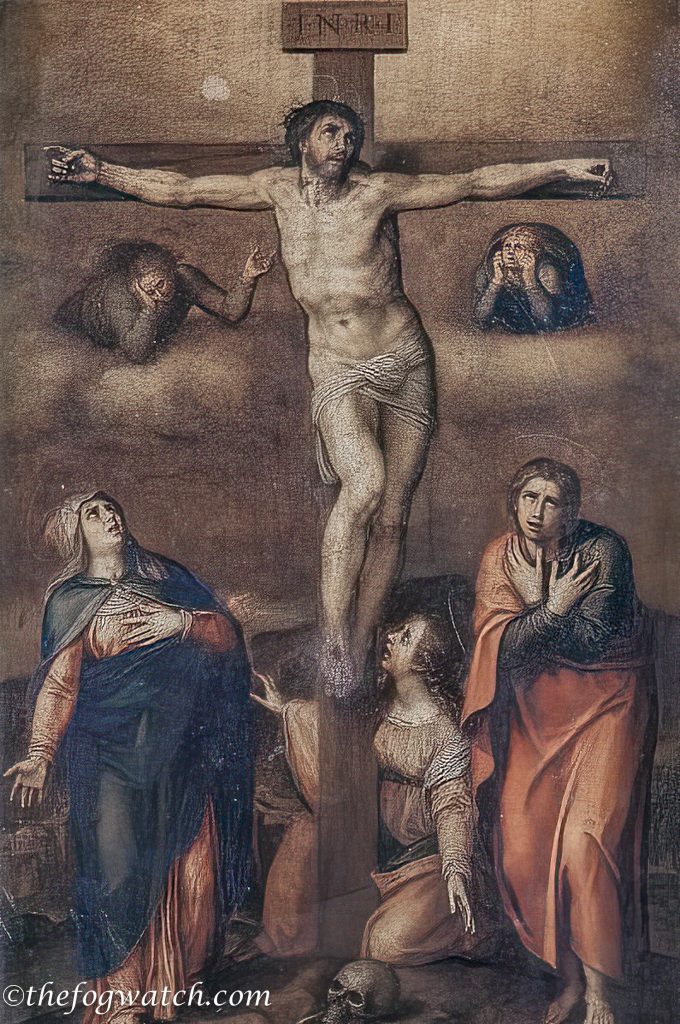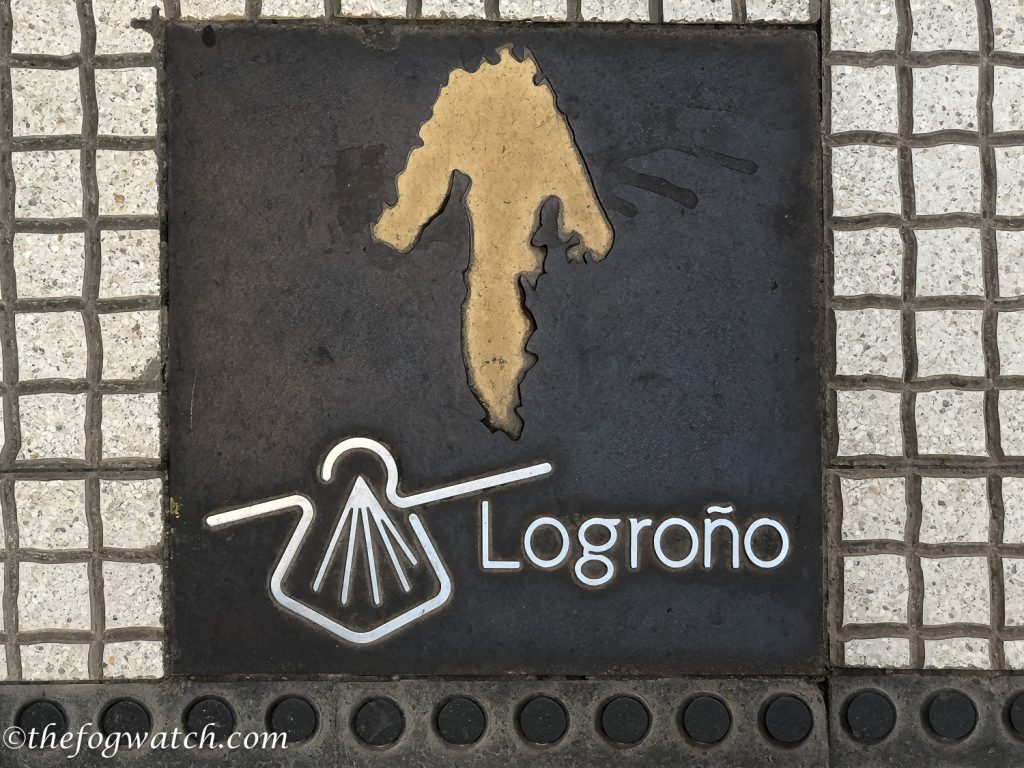Self-care on the Camino is important, and we were both definitely feeling the physical strain. Besides, we needed to stock up on a couple of items and Logroño is a decent-sized town. We went in search of a bag in order to lighten our load. The Pyrenees crossing, and the descent into Zubiri, really caused problems for Sharon. So it’s time to lighten the load if we are to make it to Santiago.
The first place we went to had very expensive bags and ridiculously expensive sunglasses (I wanted to reduce the glare). I soon found reasonably priced UV sunglasses at a local pharmacy. As for the bag, we decided to pack our heavy stuff into a dry-sac and use that for transport, leaving us with lighter backpacks but retaining the good harness system.
So with practicalities solved, we went back to our accommodation for a brisk lie-down. Then we headed out again to take in the wonderful cathedral. On the side street we found a bar with an excellent view of one of the steeples. Armed with sketchbooks and the aroma of refreshment, we took out our sketchbooks and minimalist watercolour sets. This would be a two-cervesas sketch. The waitstaff came out periodically to check out our progress, and replenish our cervesas-con-limon — a perfect way to unwind and take time out.
It’s too easy on the Camino to get caught up in the race for distance, beds and food. But that’s only the outward part of the pilgrimage. The other is learning to take time to slow down, observe, and consider the inner journey.
Sketching is a mindful activity, pushing away the concerns of the world as we concentrate on capturing the atmosphere of this inspiring cathedral with watercolour over pen and ink. It is the ultimate in slow-journalling. One thing Sharon has taught me over the years is that sketching, like photography, teaches you to look with intention. But with a sketch, you see much more than a good composition. Unlike a photo which is framed and taken before moving on, a sketch has you looking and taking in details over 1-2 hours. You start to see how each part of the cathedral depends upon every other part to achieve a unified vision that will inspire people for generations. The domed lantern focuses the sound of the bells so they ring out across the square calling the faithful to pray while startling the pigeons from their complacent perch.
And let’s face it, zooming in on a phone photo won’t give you that much information. With a sketch, you build the shapes and observe the shadows. You observe how the light falls on the stone, and the subtle variations in texture and colour. And you see how the bells sit in the openings of the spire, with circular windows above and the whole surmounted by a lantern with a ball on top, symbolic of the globe on which we live, and then the lacey iron cross to crown it all. Again, you look up and see how the octagonal structure sits on top of a square tower. We paced our sketches to the chiming of the bells every quarter hour. On the hour we counted the strikes as it has marked the time from centuries past. The clock on the side wall of the church is split into three faces: one for the hours, one for the minutes, and another for the seconds.
Logroño has long been associated with the Camino, and in the Plaza de Santiago, the ground is inlaid with a large-scale depiction of the Game of the Goose — said to be a mystical representation of the Camino journey, with links to the Knights Templar. Several landmarks of the Camino are laid out on this human-scale game board. The board is laid out like a spiral labyrinth with 64 squares mapping the path to Santiago depicting key stages along the way. As for the association with the goose? The Romans used geese as guard animals. They are quite fiercely territorial, and they are a symbol of wisdom since they fly a migratory path from East to West as though they are Camino guides to Santiago. In the game, the thirteen squares representing geese are lucky squares, as are those depicting bridges. Like the Camino, the game has stall-points as well as progressions, depending on the luck of the dice throw. The Latin word for goose is ‘Oca’ and there are a few towns along the Camino with Oca forming part of the name, such as Villafranca Montes de Oca (French town of Goose Hill).
Logroño itself is close to where the legendary ‘Battle of Clavijo’ supposedly took place in 844 CE (the archeological evidence is ambiguous), but this is the battle in which St James is said to have appeared to inspire the Christians to defeat the Moors here, giving rise to the other aspect of St James as the Matamoros, or Moor-slayer. History records a battle a hundred years later, between Ramero II and Abd’ al-Rahman III, and the two battles are now conflated in legend and oral history. That said, Arab observers recorded a spectacular solar eclipse occurring during the first day of battle, spooking both sides such that no fighting took place for two days.
“As the army arrived near Simancas, there was an awful eclipse of the sun that covered the earth of a dark yellow amid the day and it filled us and the infidels with terror as neither had seen in their life such a thing as this. Two days passed without either side making any movement.” [Martínez Díez, Gonzalo (2005). El Condado de Castilla (711–1038): la historia frente a la leyenda (in Spanish).]
Logroño sits on the triple frontiers of Aragon, Navarra, and Castille y León, a strategic location at the end of the navigable portion of the River Ebro. It was prized by the Moors and the Christians, and it changed hands several times over succeeding centuries. The town was again under attack in the C11th, when the town was held by Alfonso VI of Castille.
It was defended by Count Garcia Ordóñez (Alfonso’s brother-in-law). It turns out that the Ordóñez family had made a dangerous enemy in the form of Rodrigo Diaz de Vivar. He is otherwise known as El Cid (The Lord — a title conferred by the Moors). He had been a military General under the Castillian king, but had fallen out of favour with the king’s successor. And by now he was working as a mercenary for the Moors. El Cid conspired with the Moslem king of Zaragosa to harass the Castillians. He attacked the town in 1075, before retiring downriver, loaded with booty, to a castle about 60km away at Alfaro. He was eventually given control of Valencia, which he apparently ruled fairly, presiding peacefully over both Christians and Moors.
Today, out of sensitivity to the multi-faith and multicultural nature of the Camino, the Church is playing down the role of St James as Matamoros. Many of the sculptural depictions have been moved to less prominent places away from the altars in the churches. Or they are replaced by representations of St James as a pilgrim.
Logroño was always a strong market town. The C12th Codex Calixtinus notes, however, that:
“A huge river called the Ebro, of healthful water and abundant in fish runs through Logroño. All the rivers between Estella and Logroño are unhealthy for drinking for men and beasts, and the fish from them cannot be eaten.”
Today, of course, the food and drink are excellent as you can expect in any major town or city. And the water is safe and treated.

The wall art in Logroño is spectacular, such as this giant pilgrim tattooed with pilgrim stamps across his body. It perhaps symbolises the Camino as life, punctuated by events stamped on our memories.
We visited the Cathedral and inside, we stumbled upon a true treasure—a painting attributed to Michelangelo. The authenticity of the artwork is subject to debate, but its historical context made it an intriguing discovery. The painting sat behind multiple layers of glass, creating a challenge for photography. Nevertheless, the sight of it was a prime example of Logroño’s rich history adding further context to the Camino.
The right image is ©public domain [photo by Manuel Gómez] — Wikimedia.
Logroño proved a valuable rest on the Camino, before we moved on, lighter in pack, physically and mentally refreshed. We reflected on sketching as a mindful practice, and marveled at the artistic treasures of the Cathedral. It is where the past dances with the present, like the Game of the Goose representing the Camino journey itself.












Fascinating – my grandson has just finished his history PhD and a large part was studying pilgrim badges – he’ll love this photo you included – thank you.
Andy Lloyd Williams
Thanks Andy — I think you are referring to the wall art of the man with stamps on his chest? — these are the stamps pilgrims collect in their credential as proof they have walked the distance they claim for their Compostela. Your grandson’s PhD sounds fascinating — is he planning to write a book based on his research?
Love this Camino meditation. Thank you for starting my day
Thanks Brianne — you are most welcome 🙂